Related Research Articles

Washburn University (WU), formally Washburn University of Topeka, is a public university in Topeka, Kansas, United States. It offers undergraduate and graduate programs, as well as professional programs in law and business. Washburn has 550 faculty members, who teach more than 6,100 undergraduate students and nearly 800 graduate students. The university's assets include a $158 million endowment. As of 2008, Washburn also took over overseeing the technical school in the area, Washburn Tech.

The Carnegie Museum of Art is an art museum in the Oakland neighborhood of Pittsburgh, Pennsylvania, United States. The museum was originally known as the Department of Fine Arts, Carnegie Institute and was formerly located at what is now the Main Branch of the Carnegie Library of Pittsburgh. The museum's first gallery was opened for public viewing on November 5, 1895. Over the years, the gallery vastly increased in size, with a new building on Forbes Avenue built in 1907. In 1963, the name was officially changed to Museum of Art, Carnegie Institute. The size of the gallery has tripled over time, and it was officially renamed in 1986 to "Carnegie Museum of Art" to indicate it clearly as one of the four Carnegie Museums.
The Carnegie International is a North American exhibition of contemporary art from around the globe. It was first organized at the behest of industrialist and philanthropist Andrew Carnegie on November 5, 1896, in Pittsburgh. Carnegie established the International to educate and inspire the public as well as to promote international cooperation and understanding. He intended the International to provide a periodic sample of contemporary art from which Pittsburgh's Carnegie Museum of Art could enrich its permanent collection.

Agona Swedru is a town and the capital of Agona West Municipal District, a district in the Central Region of south Ghana. Agona Swedru has a 2010 settlement population of about 55,239 people. Akwambo is the main festival celebrated by the people of Agona Swedru and it is celebrated in the month of August. Agona Swedru is popularly known for the planting trading of plantain. The name `Swedru` was originated from the planting of plantain within the town.
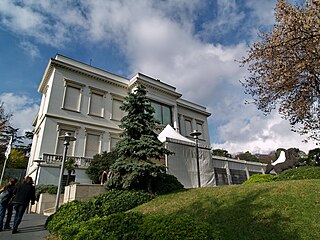
The Sabancı University Sakıp Sabancı Museum is a private fine arts museum in Istanbul, Turkey, dedicated to calligraphic art, religious and state documents, as well as paintings of the Ottoman era. The museum was founded by Sakıp Sabancı, and was opened in June 2002. Aside from permanent exhibitions, the museum also hosts national and foreign temporary exhibitions and, hosts cultural events on the weekends.
RiverSculpture! are public art displays found along the Milwaukee Riverwalk in downtown Milwaukee, Wisconsin. Information kiosks stationed near each presentation offer self-guided walking tours of this annual outdoor exhibition.

Jim Gary was an American sculptor popularly known for his large, colorful creations of dinosaurs made from discarded automobile parts. These sculptures were typically finished with automobile paint although some were left to develop a natural patina during display outdoors.

The Milwaukee Public Museum (MPM) is a natural and human history museum in downtown Milwaukee, Wisconsin. The museum was chartered in 1882 and opened to the public in 1884; it is a nonprofit organization operated by the Milwaukee Public Museum, Inc. MPM has three floors of exhibits and the first Dome Theater in Wisconsin.

The Bruce Museum is an art, science and natural history museum located in Greenwich, Connecticut.
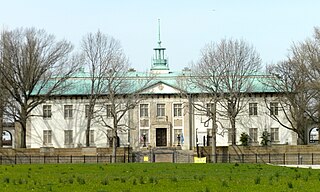
The American Swedish Historical Museum is the oldest Swedish-American museum in the United States. It is located in Franklin Delano Roosevelt Park in South Philadelphia, on part of a historic 17th-century land grant originally provided by Queen Christina of Sweden to settlers of New Sweden.
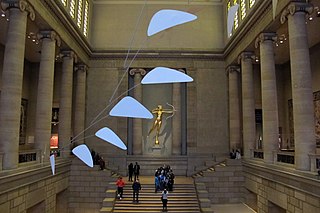
3rd Sculpture International was a 1949 exhibition of contemporary sculpture held inside and outside the Philadelphia Museum of Art, in Philadelphia, Pennsylvania, USA. It featured works by 250 sculptors from around the world, and ran from May 15 to September 11, 1949. The exhibition was organized by the Fairmount Park Art Association under the terms of a bequest made to the Association by the late Ellen Phillips Samuel.

The Washburn University School of Law is a public law school located on the main campus of Washburn University in Topeka, Kansas. Washburn Law was founded in 1903. The school is accredited by the American Bar Association and has been a member of the Association of American Law Schools since 1905.
The Greek Slave is a marble sculpture by the American sculptor Hiram Powers. It was one of the best-known and critically acclaimed American artworks of the nineteenth century, and is among the most popular American sculptures ever. It was the first publicly exhibited, life-size, American sculpture depicting a fully nude female figure. Powers originally modeled the work in clay, in Florence, Italy, completing it on March 12, 1843. The first marble version of the sculpture was completed by Powers' studio in 1844 and is now in Raby Castle, England.
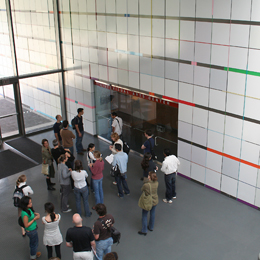
Established in 1950, the List Visual Arts Center (LVAC) is the contemporary art museum of the Massachusetts Institute of Technology. It is known for temporary exhibitions in its galleries located in the MIT Media Lab building, as well as its administration of the permanent art collection distributed throughout the university campus, faculty offices, and student housing.

East Gate/West Gate, a public sculpture by Sasson Soffer, is located on the Indiana University-Purdue University Indianapolis campus, which is near downtown Indianapolis, Indiana. This sculpture is on loan from the Indianapolis Museum of Art and was installed on campus on March 22, 2009. It was transported from the Indianapolis Museum of Art to its current location, in front of University Library, from the Indianapolis Museum of Art via helicopter. East Gate/West Gate was constructed in 1973 and consists of stainless steel pipe. Its dimensions are 24'x 40'x 30' and weighs 840 lbs.

A Woman Walking in a Garden is an oil-on-canvas painting by Dutch Post-Impressionist painter, Vincent van Gogh. This painting was created in 1887 during the two years van Gogh lived in the northern suburbs of Paris. There is a woman walking through a lush and green garden dotted with flowers and in the background there is a building concealed behind a thick row of trees. A red paint border along the edge of the canvas frames the scene.This painting is a part of the Riverbank in Clichy Triptych along with Fishing in Spring housed at the Art Institute of Chicago and River Bank in Springtime housed at the Dallas Museum of Art. All three pieces have red borders as to indicate their association to each other in a triptych.
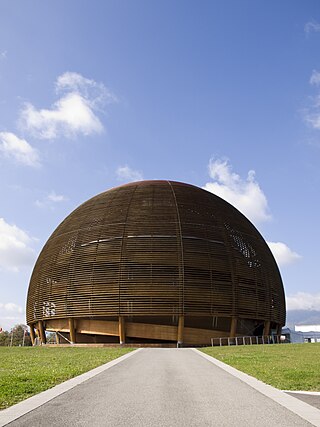
The Globe of Science and Innovation is a visitor center, designed to inform visitors about the significant research being carried out at CERN. The wooden structure, which is 27 metres (89 ft) high and 40 metres (130 ft) in diameter, is a symbol of planet earth and was originally built for Expo.02 in Neuchâtel, Switzerland. In 2004, it was moved to its current location in Meyrin in the Canton of Geneva, Switzerland.

Bill Barrett is an American sculptor, painter and jeweller. He is considered a central figure in the second generation of American metal sculptors and is internationally known for his abstract sculptures in steel, aluminum and bronze.

The Amaravati Collection, sometimes called the Amaravati Marbles, is a series of 120 sculptures and inscriptions in the British Museum from the Amaravati Stupa in Amaravathi, Guntur in the Indian state of Andhra Pradesh. The Amaravati artefacts entered the museum's collection in the 1880s. The Amaravati sculptures were sometimes also called the Elliot Marbles on account of their association in with Sir Walter Elliot, who had them removed from the site to Madras in the 1840s.
Pyramid Hill Sculpture Park and Museum is a non-profit park located in Hamilton, Ohio. The park includes an outdoor sculpture collection, a 'pioneer house' built in the 1820s, an Ancient Sculpture Museum, and a Museum Gallery for contemporary exhibitions. The Ancient Sculpture Museum includes pieces from ancient Greek, Roman, Etruscan and Egyptian civilizations. Opened in 2017, the design of the Ancient Sculpture Museum was inspired by houses from ancient Rome. The Museum Gallery, which opened in 2016, features a continuous rotation of exhibitions by contemporary artists. Visitors can get information about the art pieces through the app Otocast, some of them from the artists themselves.
References
This article's citations lack bibliographical information.(December 2017) |
- ↑ "Washburn's 2003-04 Sculpture Exhibit" Brochure
- ↑ "Barrett DeBusk / Standing Sculpture". Archived from the original on 2011-07-07. Retrieved 2011-02-01.
- ↑ WASHBURN UNIVERSITY OUTDOORS SCULPTURE EXHIBITION- http://cjonline.com/stories/031404/ent_artscal.shtml
- ↑ "Washburn's 2003-04 Sculpture Exhibit" Brochure
- ↑ UWA Outdoor Sculpture Exhibition- http://sculpture.uwa.edu/permanent/default.asp